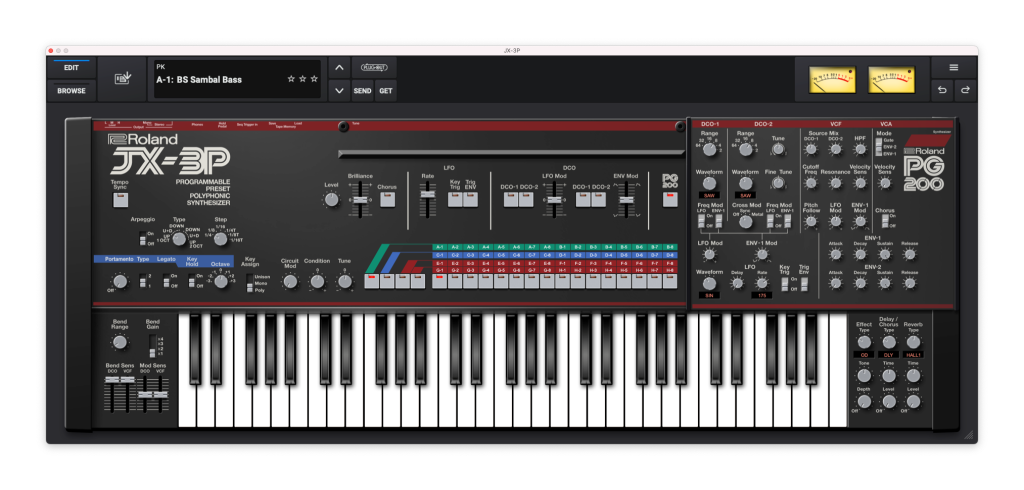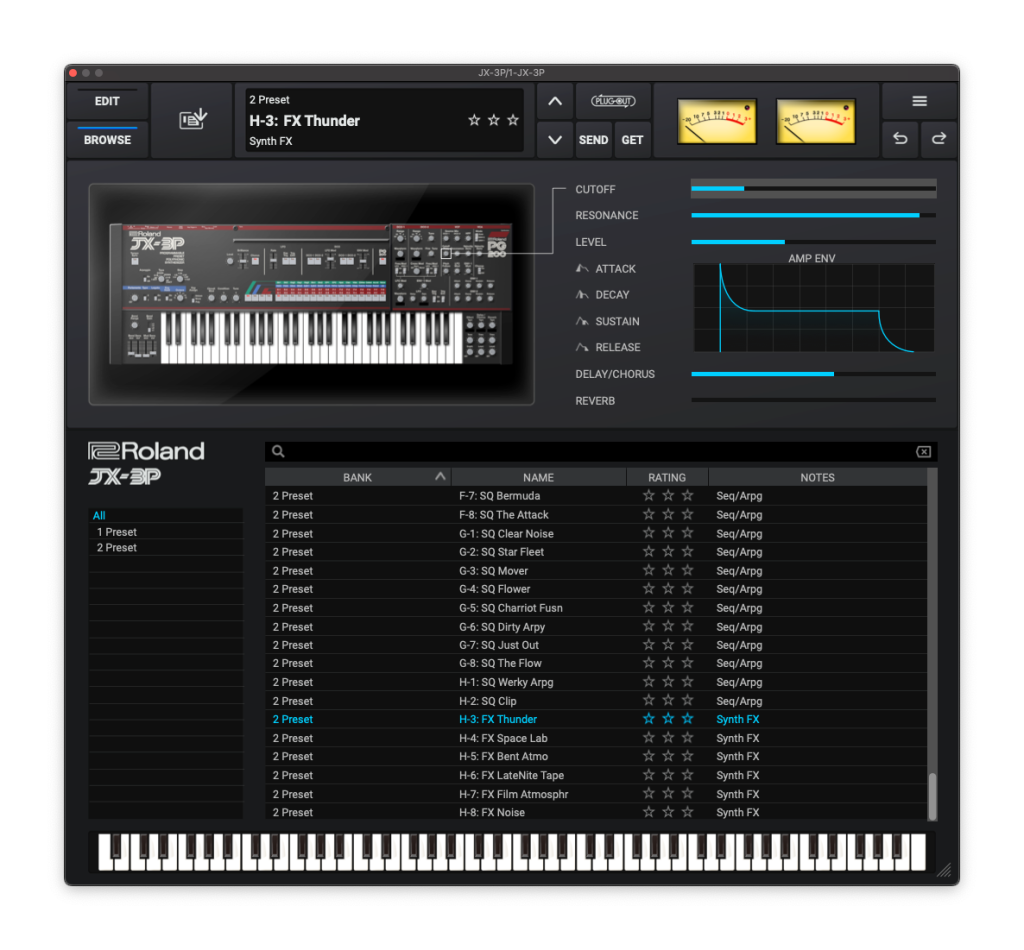Roland has been steadily overhauling their plug-in range, but this one you shouldn’t miss. The 1983 JX-3P was always an overlooked gem – think a JUNO with two oscillators, cross-mod, and more pitch modulation. But now Roland finally nails their software recreation by improving the sound and adding a simulation of the PG-200 programmer for hands-on control.
Roland Cloud’s vintage sound modeling was always really good – related to the ACB (Analog Circuit Behavior) also employed in much of their hardware. But the software was held back by some rough UI edges. The V2 overhauls making their way through the library are visually reworked with high-res graphics, they’re fully resizable (dragging the corner of the window), and they add some sonic extras like modeling tweaks and controls for fine-tuning the sound.

Roland has gone all-in on skeuomorphism here – pretty much everything is exactly where it was on the original hardware. That means that with a Roland Cloud subscription, you can pull up all of this vintage hardware and see how the source hardware would look – though this also means some non-functioning widgets onscreen, which is occasionally annoying. (If you don’t want the subscription, perpetual “Lifetime” licenses also include these as free updates.)
The Jupiter-4, Jupiter-8, and Juno-106 got the treatment in the spring, followed by the Juno-60 last month. Those are worth a look – I do love the sub-bass on the Junos, and if you want to hear what that bass sounds like, I used the plug-in on this track.)
But the JX-3P is the one I’ve been most looking forward to. In hardware form, collectors and vintage gear nuts really would want both the JX-3P and the PG-200 programmer. Without the extra knobs and switches, the JX-3P was really a chore to program. (Roland used this scheme for a number of 80s instruments.)
PG-200
Now, the fun part is that you can now use an authentic PG-200 control layout onscreen to program your JX-3P sounds. Press the PG-200 button (not authentic), and you replace the programming guide overlay from the original with knobs you can actually use. And why not be authentic? Those who know the hardware will find it familiar, and for the many folks who have never used the real hardware, you get a simulated experience of what it’s like.
Without the PG-200:

And with:

Roland has only made a few changes, and they’re all welcome ones. There are now two envelopes instead of one, most importantly. The two oscillators each have their own control instead of a single mix/balance control – which is especially useful when you’re using noise as DCO-2. And several knobs (like LFO mod) are now fully bi-directional instead of using a switch. There are also dedicated key and env trig switches, which the original lacked.
Circuit Mod and sound
But that’s all beside the point – the point is, this JX-3P sounds damn fine. Circuit Mod, which alters some of the modeling to add irregularities as you turn it up, is subtle but can produce some magical results when combined with certain patches. It can be combined with a Condition knob to simulate gear aging – also subtle, but interesting as it interacts with other settings.
Here’s just one example of how good it sounds:
And the JX-3P is just a great synth with some possibilities beyond its better-known Juno siblings. You have two oscillators with detuning. There are two cross-mod modes that can sound fantastic – sync and metal. There are pitch and LFO mod controls for each oscillator. Add that to the stuff that makes the Junos tasty, all of which have been well-modeled here, so the same interval-timer DCOs (see below) and IR3109 low-pass filter. All in all, I might prefer the JX-3P as a polysynth to the Junos for any scenario where I didn’t want the sub-oscillator. Now, plenty of modern plug-ins can do all of this, but the JX-3P is also nicely focused and not overwhelming.
Roland’s recreation now just oozes character, once you take some time to work with it – and I’d say go past those presets.
They’ve also added the usual effects, including the JX-3P’s chorus. (As on the Juno, it’s… too loud by default; it’s practically an additional noise generator with no envelope. Dial back the TONE control so it won’t sound like someone left a fan on.) Slot 1 has JX-3P chorus, overdrive, distortion, fuzz, phaser, and crusher; slot 2 is delay, pan delay, flanger, and delay+chorus, plus chorus I + II from the Juno (another reason to just pull up the JX-3P). Reverb is available with ambience, plate, modulation (a favorite), and hall 1 + 2. These are the usual Roland effects – you’ll love them, or not. But I’d be surprised at anyone who didn’t love the modeling of the synth.
By the way, Roland’s version is velocity-sensitive, too. (In actual historical terms, that required a mod/upgrade kit or the rackmount MKS-30 Planet-S. That’s slightly jarring the first time you play the real hardware since we’re used to MIDI devices all having velocity sensitivity now.)
Browser
There’s also an updated browser here, as in the other updated Roland Cloud software. It looks a whole lot better, and it’s definitely easier to navigate. But it’s still, to my mind, harder than it needs to be – they’ve added a right-click overwrite button on the main panel, but it overwrites whichever preset is active. That makes it too easy to overwrite factory presets, and still requires extra steps to save your own. It’s progress, but we’re not quite there yet. These also include some shortcuts for some parameters in the same view, though I haven’t found myself using those.

PLUG-OUT
Oh, and this is a PLUG-OUT plug-in, meaning you should get all the improvements to the ACB model on supported hardware, too. (There’s still an option to reorganize the UI to match the SYSTEM-8 hardware.) So yeah, in addition to the JX-3P being the smart used 80s Roland synth to buy, now the SYSTEM-8 plus this plug-in is a clever 21st-century used buy.
Actually, let’s check Reverb.com’s marketplace:
(if you buy something from a CDM link, we may earn a commission.)
Yeah, JX-3P prices are higher than they used to be, though still within reach and way better than the Junos and Jupiters of the world. EEPROMs and mods are available and there are a fair number of PG-200s (some bundled).
Funny enough, the System-8 is holding its price well, but that synth is surprisingly deep.
JX-3P love
I think the JX-3P quickly becomes one of the Roland Cloud plug-ins you might consider for a lifetime license if you don’t want a subscription. (The other top candidate is probably the JD-800, which is zoomable but is definitely in need of the full V2 treatment.)
And it’s one of those recreations from Roland’s past I’m grateful for today.
Some more history:
Those interval-timer digitally-controlled analog oscillators are a story on their own; the JX-3P shares the design of the Junos:
The Design of the Roland Juno oscillators [the codes]
So, too, the IR3109 four-stage OTA chip that made the 80s filters:
All about the IR3109 chip (and someone did make this board for the Shruthi, the original Mutable Instruments open-source synth, and modular)
Here’s a nice walkthrough of the original with Mathew Jonson: